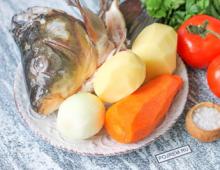Drying strawberries at home. Dried strawberries: recipes and storage rules How to dry Victoria
Strawberries are one of those plants in which not only the fruits, but also the leaves are useful. Properly dried strawberries retain their healing properties and aroma for 2 years, which is more than enough.
To prepare strawberry tea, strawberries can be dried along with the leaves and stem without picking the berries. Tie the strawberry leaves together with the inflorescences into small bouquets and hang them in a well-ventilated area.

At an air temperature of +25 degrees, such drying will take a week. Check the berries and leaves and if they are dry enough, cut the bouquets with scissors for more convenient storage and subsequent brewing of tea.

You should not leave strawberries to dry for a long time. It will dry out, lose its aroma, and flies with dust will make the healthy berry inedible and even dangerous.
Place dried strawberries with leaves in glass jars, close with a tight lid and store in a dark and cool place.
Strawberries dried in the oven or electric dryer
In this case, the strawberries are dried separately, without leaves and stalks. It is strictly forbidden to wash the berries before drying; only manual cleaning of debris is allowed.

Strawberries and wild strawberries absorb water too quickly, and during forced drying, the washed berries spread into a small blot that cannot be removed from the dryer rack or parchment paper.
In the oven, first dry the berries a little, setting the minimum temperature to about 30 degrees for 2 hours. Then increase the temperature to 50 degrees, stirring occasionally, until completely dry.

Strawberries are dried in an electric dryer for 5 hours at a temperature of 30 degrees, then dried at 65 degrees until ready.
On average, to get a glass of dried strawberries, you need 2 liter jars of fresh berries.

But who uses strawberries only for treatment, if it can become a real delicacy?
Strawberry marshmallow in an electric dryer
Strawberry marshmallows are very easy to prepare and store just as well as regular dried strawberries.
If you have any crushed strawberries left, or ones you had to wash, put them in a blender, add a little sugar and blend until smooth.

Lubricate the tray of the electric dryer with vegetable oil and place the strawberry mass in the tray, in a layer of no more than 0.5 cm. Set the temperature of the electric dryer to 60 degrees, and after 10 hours of tedious waiting, you will finally get the long-awaited strawberry marshmallow.

If you don’t eat everything right away, roll it up, cut it, and you can dry it a little more for longer storage.



For more information about drying strawberries, watch the video:
autoclave
autoclave recipes! Make jokes recipes in an autoclave? Come here!
autoclave for canning
Autoclaves for home canning You can go to our Fermash online store. Our managers will help you choose autoclave whatever you ask! Here you will find both gas and electric (universal) models, with a capacity of 5 to 28 liter cans.
On our website we collect everything possible autoclave recipes! Make jokes recipes in an autoclave? Come here!
At the beginning of the 19th century, the first canned goods appeared, separated after thermal processing, in sealed containers. However, thermal processing is now abandoned by the most common method of preparing canned food. Sterilization is one of the main technological stages Sterilization of canned food and thermal processing of the product, which ensures death bacteria by eliminating microbiological food at temperatures in a moderate climate (15-30 ° C), and sometimes at higher temperatures.It guarantees the safety of canned food for food (according to microbiological indicators Mainly, canned food is sterilized at a temperature of 120 ° C, sometimes above 100 ° C. Sterilization is intended for the preservation of canned products, which means the preservation of food value, organoleptic properties, and costliness. getting the hang of it autoclave for canning If you change the hour for preparing canned food, you are guaranteed to lose all bacteria. It is recommended to use sterilization and packaging of all types of canned food in glass containers of various sizes from 0.2 to 3.0 liters in squeezed or sealed jars.
1. Seat the jars filled with food tightly.
2. Place balls in the autoclave - jar on jar, up to Golovin. Place a wooden lattice at the bottom.
3. Fill with water, making sure to cover the jars with a ball no less than 2 cm.
4. Close the lid of the autoclave and tighten the bolts.
5. Using a car pump, pump the autoclave up to 1 atm and visually (with additional water) or by ear check the tightness of the seal. The pressure is required to save the filling of the cans, because when heated, it will leak Pressed in the autoclave itself and in the middle of the jars .
6. Heat the water in the autoclave to 110 ° C (the pressure will increase). When the temperature rises to 110 ° C, wait an hour and soak the jars for 50-70 minutes. Be sure to do this so that the temperature does not exceed 120 ° C. This processing regime achieves both the death of pathogenic organisms and the savory taste of canned food.
7. Remove from heat (simmer) and leave to cool (you can also use cold water) to a temperature of no more than 30 ° C.
8. The cob giblets will be squeezed in an autoclave. Open the autoclave, pour water through the hose and remove the jars.
It is necessary to add that the pressure gauge of the autoclave will show pressure at a temperature of 110 ° C - 2.5-3.5 atm, and at a temperature of 120 ° C - 4-4.5 atm. Then, keep pressure on the heating temperature of the autoclave and the volume of air between the lid and the jars.
Sterilization modes for canned food
Dried strawberries are widely used in folk medicine and cooking, and not only the berries, but also the leaves have beneficial properties. Properly dried strawberries retain their healing power and aroma for two years.

Methods for drying berries
Drying strawberries is a rather complex and specific process. With the slightest oversight, the fruits become moldy and rot, and when the fruits are placed in high temperatures, they lose most of their beneficial properties and become nothing more than a delicacy. The drying procedure begins with a preparatory process, in which the main key to success is a strict ban on washing the fruit. If this condition is not met, the berries will quickly ferment and rot. To ensure the relative purity of the fruits, they should be collected with clean hands and in clean, dry containers.
After the berries have been selected, you can begin to choose a drying method. Wild strawberries can be dried at home in several ways, each of which requires certain knowledge and patience.


In the oven
This option is the most common method of harvesting berries and occurs in two stages. First, the oven is heated to +30–+35 degrees, the berries are evenly distributed on a baking sheet and placed in the oven. The fruits are dried for an hour, after which the temperature increases to +60 degrees. At this temperature, the berries remain in the cupboard for several more hours, after which the baking sheet is removed. After such drying, the berries change their color to dark burgundy, the grains begin to shine and become clearly visible, and the fruits are freely separated from each other and do not stick together.
After the berries have cooled, they are poured into dark glass jars and stored. Some housewives prefer to store dried strawberries in cloth bags or paper bags.
However, this storage method has some disadvantages. The fact is that dried strawberries exude a pleasant aroma that attracts ants, cockroaches and moths, who happily devour the delicious fruits. Therefore, the most reliable way to preserve berries is glass jars.


Outdoors
Air drying requires much more time and effort than oven drying and can be done in two ways. In the first case, the berries are laid out in a thin layer on a thick cloth and taken outside. The place where the tray with fruits is located should be well lit by sunlight and ventilated. After sunset, the berry is brought home, and in the morning it is taken out into the sun again. The duration of drying strawberries in this way is from 2 to 3 weeks.
The second method is to hang the berries along with twigs and leaves. This should be done in a well-ventilated and fairly shaded place. To dry strawberries in this way, the stems with berries are collected into bouquets and tied in several pieces. Some housewives recommend lightly rinsing the bushes in cool water, and then hanging them on a stretched rope with the berries facing down. If the air temperature does not drop below +25 degrees, then in a week the bouquets will dry out.
The disadvantage of this method is the need to monitor the weather. So, at the slightest rain, bring the berries into the house. In addition, flies and other insects constantly land on plants, so strawberries dried in this way can only be used for making tea or dishes that require boiling during the preparation process.


In a convection oven
Air fryer drying is the simplest and least labor-intensive way to prepare berries. The air grill is set to +60 degrees and medium blowing speed. In this case, the drying time of the fruit will take much less time compared to the oven. This is explained by active air circulation and moisture outflow, which can be ensured by leaving a small gap in the lid. A toothpick or skewer inserted under the lid is suitable for these purposes. The disadvantage of this method is the small size of the air fryer, which means you will have to dry the berries in several batches. The capacity of an average air fryer is 0.8–1.2 kg of fruit, but the output is only 300–400 grams.


In an electric dryer
Drying in an electric dryer can take from 6 to 12 hours. The berries are laid out in one layer so that they do not touch each other, and dried at a temperature of +30 degrees for 5 hours. Then the temperature in the dryer increases to +60–+65 degrees and the fruits are dried until ready. Pallets should be checked periodically and replaced if necessary. Dried fruits do not stick together, are easily separated from the tray and do not stain your hands. After the berries are dry, they are cooled and stored in jars for storage.


Harvesting leaves
The leaves are collected for drying during the strawberry flowering period. This is explained by the fact that it is during this period that the nutrient content in the leaves of the plant is maximum, and after the fruits ripen, there is an almost complete loss of the healing properties of the leaf. When collecting, you should choose clean and undamaged leaves, which will eliminate the need to wash them and reduce the risk of the presence of parasites in them. After collection, the leaves are laid out in a dry and ventilated place, away from direct sunlight and stirred periodically. If drying is done in the oven, then setting the temperature above +45 degrees is not recommended. This will help the leaves dry evenly and not lose their healing properties. Dried leaves can be stored for one year.
Sweet and aromatic strawberries have a whole army of fans around the world. Moreover, this berry is not only very tasty, but also incredibly healthy, as it contains ascorbic acid (vitamin C), B vitamins, carotene, organic acids, sugars, pectin and tannins, mineral salts and many other chemical compounds , necessary for the human body.
Strawberries grow in sunny meadows, forest clearings, on slopes, hills and are a fairly common berry. It is also easily cultivated in garden plots. The berry ripening season does not last very long, so harvesting strawberries for future use is a pressing issue.
It is necessary to collect strawberries for drying when they are fully ripe, when they have become intensely red in color and have acquired maximum juiciness. Such fruits are easily separated from the stalks during harvesting. It is necessary to choose the right time of day for assembly; it is best to do it after the dew has dried, so that the strawberries have time to dry. Wet berries spoil easily: they become moldy and rot. That is why you should also not pick berries on a stormy rainy day. The collected fruits must be folded carefully so as not to be crushed or crushed during transportation. The best container for picking strawberries is thick wicker baskets.
The collected raw materials must be sorted out as quickly as possible, freed from debris, unripe fruits, leaves and stalks, and prepared for drying. Wash berries only if they are heavily contaminated with soil. After washing, you need to let the excess water drain by placing the berries in a sieve.
Drying strawberries at home is done in two stages. First, the berries are dried at a temperature of 25-30 degrees. This can be done outdoors, spreading the berries in a thin layer on a clean surface under a canopy, or in a dryer or oven, setting the appropriate temperature. After this, the strawberries are dried at a temperature of 50-60 degrees.
Dried berries do not stick together and easily crumble and separate from each other. Dried strawberries are dark red in color and their grains become shiny.
It is best to store dried berries in tightly sealed dark glass containers. It is this kind of container that will best prevent damage to raw materials by codling moths and other pests. The shelf life of berries is no more than two years. At the same time, if the raw material begins to become damp, it is recommended to dry it again.
However, not only strawberries are harvested using the drying method. Its dried leaves and roots also have healing properties. These parts of the plant must be harvested during the strawberry flowering period, which usually occurs in May. When collecting leaves, it is unacceptable to tear them completely off the bush, which may negatively affect the future harvest of berries. The roots should be taken at a distance from each other so as not to destroy the thickets of the plant. Before drying, the roots are thoroughly washed in cold water.
Drying both leaves and roots is quite easy; to do this, they are laid out in a thin layer and left to dry completely in the open air, stirring occasionally. You can also dry these parts of the plant in dryers at a temperature of 45 degrees. The finished raw material is quite fragile, easily crumbles and breaks. It is best to store dried leaves and roots in linen bags in a dry place. The shelf life of leaves is 1 year, and roots - 3 years.
Home-dried strawberries are used to make cakes, desserts, and drinks. In folk medicine, an infusion of dried berries and leaves is used internally for diseases of the gastrointestinal tract, urinary system and as a general tonic, and also externally for the treatment of wounds, ulcers, and acne. A decoction of the roots is prescribed as a lotion for hemorrhoids.
Our experience of drying strawberries in the Ezidri dryer.
We took hard, slightly unripe strawberries. It is not recommended to dry crushed strawberries, but they can be turned into wonderful ones. We washed them and removed the tails. We cut 5 mm plates into slices. Placed on trays in a single layer and dried for approximately 9 hours. The pieces of dried strawberries became brittle and did not stick to the fingers. Drying 13 times.
Dried berries are placed in an airtight ceramic or glass container, or in a gauze bag, and placed on a shelf in a dry room. It is necessary to ensure that the container is not exposed to sunlight. When properly stored, the berries retain their taste for 2 years.
************************************************************************
Strawberries are a healthy treat for kids and parents. Eating and variety of dishes depends on the imagination of the hostess. Dried berries are added to cocktails, tea, and used as dessert. You can prepare puree soup, confectionery powder, boil jelly, add them to yogurt and ice cream. Anything with strawberries will be incredibly delicious. Dried berries can be crushed into powder and used as a flavoring in baked goods.
Confectionery powder made from dried strawberries.
Beautiful and undamaged berries are washed, cut into small longitudinal slices and sent to an electric dryer. After drying, the strawberries are crushed in a blender, coffee grinder or food mill. The result is an aromatic powder, which is used to prepare flour products, sweets, and drinks. You can sprinkle the powder on finished cakes and pastries, or cook delicious oatmeal.
A few pieces of dried berries are added to the teapot along with the usual tea leaves and covered with warm material for infusion. Fragrant and fortified tea with a delicate taste and aroma improves immunity, which is important during the off-season and winter.
Strawberries retain all their beneficial substances after drying. But how nice it is to drink strawberry tea on a winter evening, eat a cake or pie with strawberries and enjoy the taste of summer. Strawberries should be present in the diet all year round, because one small handful of berries will protect the body from diseases. Whatever one may say, strawberries in winter are the healthiest and most delicious dried berries.


